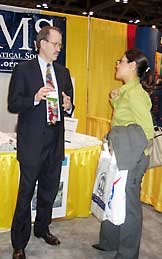
Mathematics at the 2004 SACNAS Conference
 |  |
The 2004 conference of the Society for Advancement of Chicanos and Native Americans in Science (SACNAS), held in Austin, Texas, October 21-24, included mathematics on the program--thanks to a coordinated effort by an active group of mathematicians who are SACNAS members. The conference theme, "Science & Science Policy: Constructing an Inclusive Paradigm" featured keynote and conference speakers, awards, student poster presentations, and social events. The American Mathematical Society (AMS) was among the conference session sponsors and was among the 191 exhibitors--colleges and universities, societies and associations, research centers and government agencies--that provided information about educational programs and career opportunities in the sciences. Generous support from the National Security Agency (NSA) allowed many math students to attend the SACNAS Conference. The AMS exhibit drew K-12 science teachers, undergraduate and graduate students, Research Experiences for Undergraduates leaders and faculty.
Mathematics-related highlights of the conference:
* Manuel P. Berriozábal (University of Texas at San Antonio) was awarded the 2004 SACNAS Distinguished K-12 Educator Award. He has authored and co-authored many papers on mathematics and mathematics education, provided women and minorities access to careers in science and engineering, and has over the years received numerous awards and citations for his teaching, mentoring and outreach.
* PRE-CONFERENCE CONCURRENT MATHEMATICS INSTITUTE SESSIONS, sponsored by the National Science Foundation (NSF) and the National Seccurity Agency (NSA).
o Coding Theory, co-chaired by John Little (College of the Holy Cross) and Edward Mosteig (Loyola Marymount University)
o Mathematics Methods in Bioinformatics, co-chaired by Karen Duca and Reinhard Laubenbacher (both at the Virginia Bioinformatics Institute)
* UNDERGRADUATE STUDENT POSTERS ON MATHEMATICS, presented (noted by *) in the exhibit hall on Friday afternoon and Saturday morning.
 |  |
The prizewinning poster was The role of vaccination in the control of SARS, presented by Julijana V. Gjorgjieva*, Jessica A. Snyder and Kelly R. Smith. The other undergraduate posters presented were:
o Mathematical and physical concepts applied in using LEGO Mindstorm microprocessors, by Carmelino Castillo, Jr.* and David Cecil
o Investigation of stochastic behavior of pancreatic B-cells, by Camille R. Daniel* and Arthur Sherman
o On estimating survival function of stochastic order, by Juan Gallegos*, Daisy (Yan) Huang, Thien T. Nguyen and Gregory Schrage
o Using the web to understand mathematical problems and reinforce mathematical skills, by Jose F. Gonzales* and Andre Cherkaev
o Displacement analysis on a three-layered elastic strip subjected to heaviside loading, by Nancy Rodriguez*
o Cellular noise and the aging process, by Tommy Begay*, Nick E. Dowdall, Mat Gluck and Olaoluwa Okunola
o HIV and its impact on the infant immune system, by Antonio Buenrostro*, Katie Diaz, C.P. Gonzalez and Magdaliz Gorritz
o Does gravitational gossip weigh heavy on your local access network (LAN)?, by Wilbert Fernandez*, Anthony Brillups and Reynaldo Castro-Estrada
o Agent based modeling of eciton burchelli swarm patterns, by Alberto Izarraraz*, Jose Almora, Qiao Liang and Crystal Nesmith
o Modeling of tumor growth and its control via paclitaxel using a delay differential equation, by Yi Lin*, Kevin Flores and Lauren Hannah
o the impact of mosquito-bird interaction on the spread of west nile virus to human populations, by Pablito A.M. Delgado*, David L. Perez, Cynthia H. Sanchez-Tapia and Diego Chowell-Puente
o Viscoelasticity in blood clots, by Lucinda D. Robledo*, Elena Cherkaev and Carolos Bionifais-Lista
o Lower bounds on the matching number of bipartite graphs, by Iride V. Gramajo* and Ermelinda DeLaViña
* GRADUATE STUDENT ORAL PRESENTATIONS:
The prizewinning presentation was A graph-theoretic method for the discretization of gene expression measurements, by Elena S. Dimitrova.
The other graduate mathematics presentations were:
o Decision modeling and monitoring efficacy of public health initiatives by utilizing topological networks and the Alvarez-Pasam Method, by Angel A. Alvarez
o An example of a computational method for control of reentrant queues in a bounded domain, by Jose María Menéndez
* Shapes, Images, and Deformations, sponsored by the AMS, was co-chaired by Ricardo Cortez (Tulane University) and Estela Gavosto (University of Kansas). The other symposia participants were Pablo Negron (University of Puerto Rico), Oscar Gonzalez (University of Texas, Austin) and Helen Moore (ARCC)
* Got Statistics?, presented by Robert Santos (NuStats) and Javier Rojo (Rice University)
There were other sessions related to bioinformatics, materials science, mathematics education, and issues related to graduate programs, networking and non-academic career choices in the sciences.
* K-12 TEACHER WORKSHOPS:
o Rethinking Basic Math and Algebra, presented by Sandra Algarin (Radians School) and Edric Cane (Edric Cane Seminars and Publications)
o Ours Not to Reason Why, Just Invert and Multiply: Dividing Fractions with Meaning, presented by Holli Hall (Veda Knox Elementary School) and Christopher Kribs Zaleta (University of Arlington, Texas)
o Secrets of the Platonic Solids: the Ancient Greeks Knew Them and We Can Too!, presented by Lynn McGrath and Perla Lahana Myers (both at the University of California, San Diego)
 |  |
* AMS EXHIBIT
Jim Maxwell, Director of AMS Meetings & Professional Services, and Diane Boumenot, Manager of AMS Membership & Programs, were on hand to answer questions related to REU and graduate programs, career opportunities in mathematics, and resources for mathematics educators and professionals. The AMS displayed books and materials on mathematics for students and teachers, including a What can I do with a math degree? poster.

Visit the AMS Surveys and Outreach web pages or email prof-serv@ams.org for more information on graduate studies in mathematics.
The AMS is proud to support the annual SACNAS meeting and its programs that encourage advanced education in the mathematical sciences. AMS members who would like to become involved in or who wish to find out more about SACNAS are invited to visit the SACNAS website.
See also the report on Mathematics at the 2003 SACNAS Meeting.

